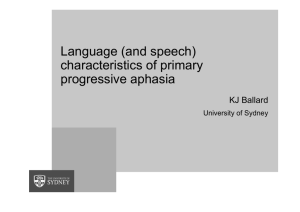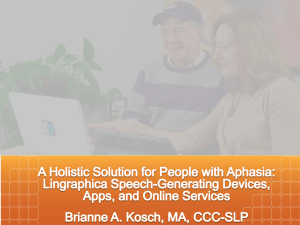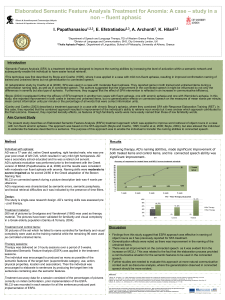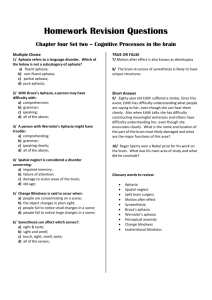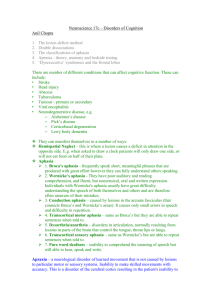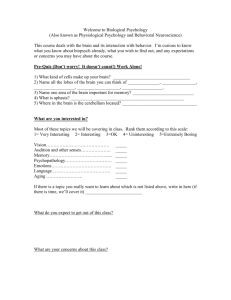Gestural Verbal Treatment - Midwestern Adult Communication
advertisement
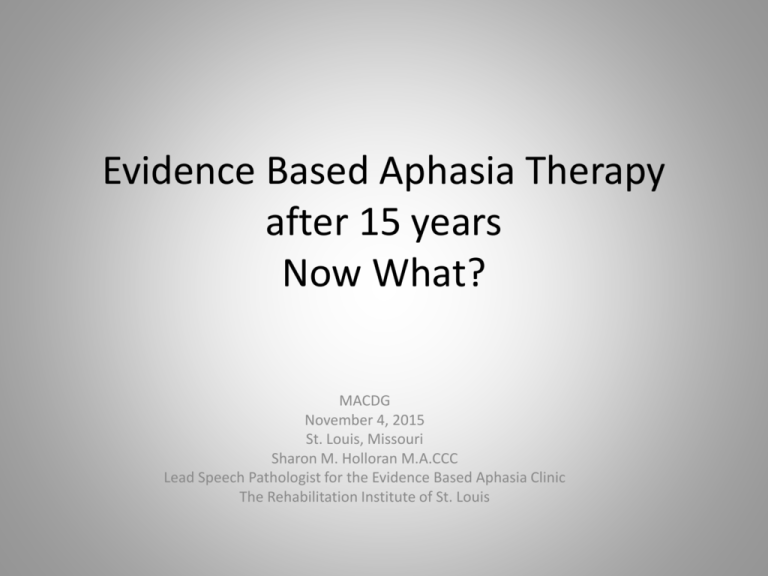
Evidence Based Aphasia Therapy after 15 years Now What? MACDG November 4, 2015 St. Louis, Missouri Sharon M. Holloran M.A.CCC Lead Speech Pathologist for the Evidence Based Aphasia Clinic The Rehabilitation Institute of St. Louis EBAC Patients (2001-2014) (not including 25 extremely severe patients, and non-covered) Characteristic Male Female Number/316 Percentage 184 132 Age 58.2% 41.8% 57.2+15 (16-90) Anomic Global Mixed nonfluent Wernicke’s Transcortical sensory Broca’s Transcortical motor Conduction Unclassifiable 101 66 27 23 17 16 8 3 27 32% 21% 8.5% 7.3% 5.4% 5.1% 2.5% <1% 8.5% Fluent Non-fluent 191 125 60% 40% Weeks post-event (range) 38.1 + 118.3 (1-1248) EBAC Patients (2001-2014) Etiology Number/316 Percentage LMCA ischemic stroke 194 61% Left hemorrhagic stroke 66 21% Left subcortical only ischemic stroke 16 5% Left hemisphere tumor 13 4% Left hemisphere traumatic brain injury (TBI) 11 4% Left ACA or PCA ischemic stroke, or subarachnoid hemorrhage 6 2% Infectious, seizures or multiple 16 sclerosis 5% EBAC Patients (2001-2014) Baseline Measures (pre-treatment) BDAE Language Competency Index (LCI) Mean (sd) Possible range 37.9 (28) 0-100 38.3 (31) 0-100 37.4 (30) 0-100 Boston Naming Test (BNT) 19.5 (20) 0-60 Communication Activities of Daily Living (CADL-2) 63.9 (26) 0-100 ASHA Quality of Communication Life Scale 3.78 (0.7) 0-5 Communication Effectiveness Index (CETI) 53.4 (23) 0-100 LCI-Expressive LCI-Comprehension Levels of Evaluation of Change 6-month 5-month 4-month 3-month 2-month 1-month Baseline Aphasia diagnostic exam X X Nonverbal cognitive testing X X Mood/QOL/functional comm. X X Family rating of change X X X X X X X Discourse measurement X X X X X X X Treatment data-trained X/X X/X X/X X/X X/X X/X X/X Treatment probe-untrained X/X X/X X/X X/X X/X X/X X/X Treatment probe-control behavior X/X X/X X/X X/X X/X X/X X/X Measurement • Neuropsychology Measures – Boston Diagnostic Aphasia Evaluation – Communication Activities of Daily Living-2 (CADL-2) – Boston Naming Test – ASHA Quality of Communication Life – Visual Analog of Mood Scale Speech-Language Measures • Western Aphasia Battery (WAB)-Initial Evaluation – Aphasia Quotient • Communication Effectiveness Index (CETI)-monthly – 16 items to rate client with aphasia • Discourse Comprehension Test-monthly – 2 stories , 8 y/n questions on each • BDAE Discourse Production Measure (Aesop fable story retelling)-monthly – Story retelling task yields 3 scores Scoring • CETI - mark a line 10 cm long on 16 items and find average • DCT- read 2 stories, ask 8 y/n ?’s per story • Discourse Production- retell Aesop’s fable & record • Ideally linded SLP takes measures and transcribes & scores Discourse Production PROBE • Video of Aesop’s Fables Medical Record # EVIDENCE-BASED APHASIA CLINIC TRACKING FORM Client: _______________________________ D.O.B.: ________ Diagnosis: ____________________________ Age: ____ Onset: ______________________ Aphasia Subtype: _________________________________________________________ Lives with: _____________________________________________________________ Initial NP/AD Date: ______________________ 6 month follow-up:_____________ BDAE-3 LCI: ___________ Aud Comp: _____ Expression: ______ CADL-2: ________________ CETI: ______________ WAB/ADP Date: ____________________ BNT: ____ ASHA QOC: ___________ Score: ___________ Goals: ________________________________________________________________ Current communicative behavior/ Communication Partner _____________________________________________________________________________________ ___________________________________________________________ Date Date Date Date Date CETI Score Client Other Discourse Comprehension probe M______ D______ x/16 Raw score____% Discourse Production Probe -folder # -Time Clauses/utterances # content units/ total Efficiency cu / # seconds Fable / Content units fox/stork 23 lion/mouse 33 fox/crow 24 rabbit/turtle 20 Date Development of an EBAC (2001) • Development of treatment care paths – Care paths for primary areas of language competence • • • • Verbal expression Auditory comprehension Reading Written language – Include treatments aimed at activity/participation level EB Activity/Participation Treatments Primarily Compensatory for Communication Promoting Aphasics’ Communicative Effectiveness (PACE; Li et al., 1988)III Supported Conversation for Adults with Aphasia (SCA; Kagan et al., 2001) I Visual Action Therapy (VAT; Helm-Estabrooks et al., 1982)III Formal drawing program (Lyon & Sims, 1986) III Computerized Visual Communication System (C-ViC; Steele et al., 1989)III Lingraphica system (Aftonomos et al., 1997) III Training in gestural sign language (American Indian; Skelly, 1979)III Partner training in facilitative behavior (Simmons et al., 1987) E Conversational coaching (Holland, 1988) E Sentence Production Program (Helm-Estabrooks & Ramsberger, 1986)III Wh-interrogative production treatment (Thompson et al., 1993)II Verbal cueing for sentence production (Loverso et al., 1998)III Primarily Restorative for Communication Constraint-induced aphasia therapy (CIT; Pulvermuller et al., 2001)I Group therapy in functional situations (Aten et al., 1982)III Voluntary Control of Involuntary Utterances (VCIU; Helm & Barresi, 1980) E Treatment of Aphasic Perseveration Program (TAP; Helm-Estabrooks et al., 1987) III Conversational script training (Cherney et al., 2008) III Mapping therapy (Byng et al., 1994)III Syntactic EB Impairment-Level Treatments Apraxia of speech? No Yes Is deficit phonologic, semantic or syntactic? Semantic Semantic feature analysis (Lowell et al., 1995)III Feature-contrasting technique (Hillis, 1998)III Multistage semantic treatment (Drew & Thompson, 1999)III Personalized cueing (Freed & Marshall, 1995)III Lexical-semantic therapy: BOX (Doesborgh et al., 1993)I Word-picture matching (Marshall et al., 1990)E Gestural+verbal treatment (Raymer st al., 2006)III Phonologic Melodic Intonation Therapy (MIT; Sparks et al., 1974)III Contrastive stress/imitation of contrasts (Wambaugh et al., 1998)III Response Elaboration Training (RET; Kearns, 1985)III PROMPT technique (Hayden, 1999)E Phonologic naming therapy (Robson, 1998) III Phonologic therapy (Nettleton & Lesser, 1991) III Phonologic hierarchy (Greenwald et al., 1995) III Retraining O-P/P-O conversion (Kiran et al., 2001)III Phonological components analysis (PCA) therapy (Leonard et al., 2008)III Word discrimination therapy (Fisher et al., 2009)III Verbal Expression Treatments Primarily Compensatory for Communication Promoting Aphasics’ Communicative Effectiveness (PACE; Li et al., 1988)III Supported Conversation for Adults with Aphasia (SCA; Kagan et al., 2001)I Visual Action Therapy (VAT; Helm-Estabrooks et al., 1982)III Formal drawing program (Lyon & Sims, 1986)III Computerized Visual Communication System (C-ViC; Steele et al., 1989)III Lingraphica system (Aftonomos et al., 1997) III Training in gestural sign language (American Indian; Skelly, 1979III , Simmons & Zorthian, 1979) Partner training in facilitative behavior (Simmons et al., 1987) E Conversational coaching (Holland, 1988) E Back to the Drawing Board Drawing to facilitate naming (Farias, Davis & Harrington, 2005) Miscellaneous Restorative for Speech Production/Communication Constraint-induced aphasia therapy (CIT; Pulvermuller et al., 2001)I Group therapy in functional situations (Aten et al., 1982)III Voluntary Control of Involuntary Utterances (VCIU; Helm & Barresi, 1980)E Treatment of Aphasic Perseveration Program (TAP; Helm-Estabrooks et al., 1987) III Conversational script training (Youmans et al., 2005, Cherney et al., 2008)III Thematic Language Stimulation (Chapey, 2008) Semantic/Lexical Retrieval Programs Response Elaboration Training (Gaddie, Kearns, Yedor, 1991) Semantic feature analysis (Lowell et al., 1995)III Semantic feature analysis + Response Elaboration Training (Conley & Coelho, 2003) Feature-contrasting technique (Hillis, 1998) III Multistage semantic treatment (Drew & Thompson, 1999)III Personalized cueing (Freed & Marshall, 1995)III Lexical-semantic therapy: BOX (Doesborgh et al., 1993) I Word-picture matching (Marshall et al., 1990) E Complex Semantic Naming Program (Swathi-Kirin, 2003) Gestural+verbal treatment (Raymer st al., 2006)III Phonologic Programs Phonologic naming therapy (Robson, 1998)III Phonologic therapy (Nettleton & Lesser, 1991)III Phonologic hierarchy (Greenwald et al., 1995)III Retraining O-P/P-O conversion (Kiran et al., 2001)III Phonological components analysis (PCA) therapy (Leonard et al., 2008)III Word discrimination therapy (Fisher et al., 2009)III Syntactic Programs Sentence Production Program (Helm-Estabrooks & Ramsberger, 1986) III Wh-interrogative production treatment (Thompson et al., 1993)II Verbal cueing for sentence production (Loverso et al., 1998) III Mapping therapy (Byng et al., 1994) III Verb Network Strengthening Treatment (VNest) (Edmonds, Nadeau, Kiran, 2009) Semantic feature analysis + Response Elaboration Training (Conley & Coelho, 2003) Apraxia Programs- See Apraxia of Speech Decision Tree Auditory Comprehension Treatments Impaired Pre-Linguistic Processing Attention Process Training (APT)E Noise reduction Pausing Primarily Compensatory for Auditory Comprehension Environmental support (patient and family training) (written, pictorial, gestural cues)E Formal drawing program (Lyon & Sims, 1986)III Miscellaneous Restorative for Auditory Comprehension Treatment for Wernicke’s Aphasia (TWA) (if word reading/pic match) E Training in speech (lip) reading Phonologic training Amphetamine treatmentI Training in speech (lip) reading Schuell Auditory Comprehension Tasks (if word-level deficit) Complex Semantic Naming Treatment (Swathi-Kirin, 2003) Situational Therapy for Wernicke’s Aphasia (Altschuler et al., 2006) Visual Action Therapy (VAT; Helm-Estabrooks et al., 1982)III Sentence/Discourse Level Programs that Target Auditory Comprehension Verb Network Strengthening Treatment (VNest) (Edmonds, Nadeau, Kiran, 2009) Response Elaboration Training (Gaddie, Kearns, Yedor, 1991) Script Training (Youmans et al., 2005) Reading Treatment Programs Primarily Compensatory for Communication Phrase-formatted text (PFT) use (Beeson & Insalaco, 1998)III Training in head turning for right visual field deficit (Daniel et al., 1992) E Environmental support – noise reduction (Kilborn, 1991)E Hyphenation by grapheme units (Harley & O’Mara, 2006)E Primarily Restorative for Communication Attentional training (Coelho, 2005)E Computer-supported reading treatment (Katz & Wertz, 1997)III Intensive stimulation approach with written input (Schuell) E Letter Identification Kinesthetic reading (Seki et al., 1995)III Motor cross-cuing for reading (Maher et al., 1998) III Semantic-Lexical Treatments for Pure Alexia (Letter-by-Letter Reading- impaired access to orthography) Multiple oral re-reading (MOR; Moyer 1979III , Kim & Russo, 2010) Rapid categorical judgments (Friedman & Lott, 2000)III Rapid lexical judgments with corrective feedback (Hillis, 1993) III Train word-picture matching with corrective feedback (Hillis & Carmazza, 1994) III Phonological Treatments Retraining grapheme to phoneme conversion (Kiran et al., 2001)III Lindamood Phoneme Sequencing Program (Conway et al., 1998) III Training bigraphs/orthographic-phonemic conversion (Friedman & Lott, 1996) Training homophones in sentences (Scott & Byng, 1989) Phonological Treatment Program (Beeson, 2010; Protocol) Persistent reading impairment at word level or above Oral reading for language in aphasia (ORLA; Cherney, 1995) III Oral reading treatment (ORT; Orjada & Beeson, 2005)III Mapping therapy (Schwartz et al., 1994)III Hierarchical cued oral reading for corpus of words (Hillis & Carmazza, 1994)III Conversational script training (Cherney et al., 2008)III Written Language Treatments Global Agraphia- retrain spellings for specific words Anagram and Copy Treatment (ACT; Beeson, 1999)III Copy and Recall Treatment (CART; Beeson et al., 2002, 2003)III Phonological Agraphia- retrain sound-letter correspondences Phonological Treatment Program (Beeson, 2010; Protocol) Lindamood Phoneme Sequencing Program (Conway et al., 1998) III Surface Agraphia- difficulty with irregular words Phonologic problem solving for spelling- Interactive Spelling Treatment (Beeson et al., 2000; Protocol) Primarily Compensatory for Communication Environmental support – spell check, space, keyboard (X)E Apraxia of Speech Nondiscriminative Primary Clinical Characteristics: slow speech rate sound distortions errors relatively consistent in type prosodic abnormalities Nondiscriminative Clinical Characteristics articulatory groping perseverative errors Speech initiation difficulty awareness of errors automatic speech better than propositional speech islands of error-free speech Clinical Characteristics that Cannot be used to diagnose AOS anticipatory errors transposition errors limb or oral apraxia express-receptive language gap Treatment Approaches: Articulatory Kinematic PROMPT (Bose, 2001)III Sound Production Treatment (Wambaugh, 1998)III Minimal pairs (Wambaugh, 1996)III Articulatory posture drawings, modeling, self-initiated postural cueing, mirror monitoring, practice (Raymer, 2002)III Modified RET (Wambaugh & Martinez, 2000) Script Training (Youmans, 2011) AAC Instruction to use writing (Lustig, 2002)III Electrolarynx (Marshall, 1988)IV Training with communication books, alphabet supplementation, voice output aid (Yorkston, 1989)IV Blissymbols (Lane, 1981; Bailey, 1983)IV Total communication; signing (Fawcus, 1990)IV Rate and/or Rhythm Repeated Practice with rate/rhythm control (Wambaugh, 2000)III; (Wambaugh et al., 2012) Metronome with Hand-Tapping (Mauszycki & Wambaugh, 2008) Training prolonged speech to reduce rate via computer based program (Southwood, 1987)III Stress patterning practice-modeling and auditory feedback (Tjaden, 2000)IV Intersystemic Reorganization Production of gestures (Dowden, 1981)IV; Gestural-Verbal Treatment (Raymer, 1991)III Pairing verbalization with AmeriIndian production (Skelly, 1971)IV Gestural reorganization (tapping) with imitation of contrasts drills (Wertz, 1984)III Choral singing, phrase production in song (Keith, 1975)IV Melodic Intonation Therapy (Sparks et al., 1974)III; (Hurkmans et al., 2012) Exlusionary Characteristics: fast rate normal rate normal prosody Effect Size • Effect size refers to a family of indices specific to single subject design that establishes the magnitude of gain from treatment. • Effect size is defined as a “ quantity that describes the degree to which a treatment outcome differs from zero.( Beeson & Robey, 2006 ) Effect Sizes • Small effect size = 0.2 • Medium effect size = 0.5 • Large effect size = 0.8 Effect Sizes (d) Word-finding treatment for anomia in aphasia 1.66 Viagra (oral sildenafil) vs. placebo and self-reported change from baseline in sexual functioning 1.60 Effect of low dose prednisone vs. placebo on number of swollen joints in rheumatoid arthritis 1.05 Computerized cognitive rehabilitation post-stroke 0.54 Effect of donepezil on cognition in Alzheimer’s 0.51 Improvement in depression with paroxetine vs. placebo 0.21 Wisenburn & Mahoney, 2009; Althoff et al., 2003; Katzman et al., 2007; Winblad et al., 2009; Saag et al., 1996; Cha & Kim, 2013 Effect Sizes • Wisenburn and Mahoney, 2009 • Completed a meta-analysis of 44 studies and 107 effect sizes that just came out this year • Analysis of various approaches for word finding deficits in people with aphasiasemantic, phonological, and mixed • Revealed semantic therapy appeared to have better generalization to untrained words Aphasia Treatments How to implement programs in your setting. MACDG November 4, 2015 St. Louis, Missouri Jacque Livingston M.A.CCC Speech Therapist at The Rehabilitation Institute of St. Louis The Rehabilitation Institute of St. Louis EXPRESSIVE PROGRAMS (In order of typical progression) • • • • • • • PROMPT Gestural Verbal Treatment (GVT) Script Training Semantic Feature Analysis (SFA) Phonological Component Analysis (PCA) VNeST Response Elaboration Treatment (RET) Tactile treatment for motor speech disorders • PROMPTS for Restructuring Oral Muscular Phonetic Targets • Used with patients 6 months of age onward. • Speech Pathologists are the only professionals with the prerequisite knowledge to apply PROMPT • To become fully trained in PROMPT, a clinician must complete four essential steps to be able to fully understand the PROMPT technique and apply it appropriately to patients • Introduction to PROMPT, Bridging PROMPT to intervention, The PROMPT technique self study, PROMPT Certification: A Self-Study Project • Website: promptinstitute.com Using Tactile Prompts in Therapy • • • • • Voicing/Breath Labial Jaw Height Lingual Valving Voicing • Start here in the non verbal patient • May need oral stimulation (e.g. tactile, thermal, gustatory) before treatment to prime articulators • Tactile prompt to diaphragm, chest, and larynx • Teach inhale then voicing on exhale • Prompt mouth open to initiate voicing Labial placement • Video labial closure/labial retraction • Video labial rounding • • • • Labial opening (voicing) Labial closure (bilabials) Labial retraction (/i/) Labial rounding (/o/ /oo/) Lingual Placement • Video for velar placement • Use verbal cue for lingual placement and position o Front, middle, back • Use modeling for visual and phonemic cues • Decrease cueing hierarchy, tactile→verbal →visual →independent Nasals • • • • • • Video for nasal sound Prompts for valving on /m/ /n/ Prompt for air through nose Prompt for lingual postion of /n/ Prompt for labial positions of /m/ Use with minimal pairs, ex mom vs mop teaching pt to redirect air from nasal cavity to oral cavity Putting it together • Video of Prompt workshop Gestural Verbal Treatment GVT Gestural Verbal Treatment • Targets verbal production • Pt population typically non fluent with mild to severe aphasia/apraxia of speech • Pair intact gesture to facilitate production of verbal expression • Target gestures should be functional • May increase from word to phrase length verbalizations • Use gesture which best illustrates target word Gestural Verbal Treatment 1. Target pic placed in front of subject and a model of the verbal and gestural target provided 2. Gesture elicited in isolation following a model 3. Verbal production elicited in isolation following a model 4. Verbal and gestural responses are modeled together while client produces simultaneously 5. Verbal and gestural response elicited together without a model 6. Each training item is presented two to three times per treatment session. Gestural Verbal Treatment Video • Video of GVT Script Training Script training • Script Training was initially developed to promote verbal communication on client-selected topics (Holland, Milman, Munoz, & Bays, 2002)Goal is for individuals for whom speech is no longer automatic to produce islands of fluent speech in conversation • Previously used as a treatment approach to improve automatic language production in adults with aphasia • To become automatic, scripts must be practiced as phrase or sentence-length units vs. syllable or ‘one word at a time’ approach (Youmans, Holland, Munoz, & Bourgeois, 2005) • For individuals with expressive speech difficulties repeated practice of phrases and sentences can lead to automatic and effortless speech productions Script Training • Work with patient to create 3 scripts. Each script should consist of 3-4 relatively short sentences. – Example: Conversation Starters: • • • • • How are your grandchildren? Good morning. I’ll see you later. What’s new? Utilize cuing hierarchy to introduce scripts. – Phrase repetition – Choral reading with clinician – Independent production • • • When the client can produce a newly trained phrase independently at least 20 consecutive times a new script is added or more information is added to mastered script. Patient’s are expected to practice scripts at home for 15 minutes per day. Once a script is mastered, generalization training is initiated. – Clinician purposefully varies response and comments to help the participant make scripts more resilient and more flexible. Script Training Data Collection DATE 6/14/12 Script 1 Time Script 2 Time Script3 Time 6/4/12 6/19/12 6/21/12 6/28/12 7/2/12 7/5/12 7/10/12 7/12/12 7/17/12 7/19/12 40 60 70 90 96 90 93 94 96 96 3:00 2:45 1:56 1:35 1:13 1:13 1:10 1:27 1:02 1:00 39 38 81 86 95 95 99 5:00 2:25 2:05 2:10 1:11 1:20 1:01 78 2:47 Semantic Feature Analysis Theory of SFA • There are strong neural connections between related concepts • There is better access to word-finding within categories • SFA allows pt’s to self cue by activating these neural connections • The 2009 study by Antonucci – pts treated with SFA during discourse production tasks showed improvements in general communication efficiency • 2010 Peach and Rueter – showed that targeting word finding behaviors in connected speech generalized to naming of untrained object and action pictures Model for SFA • SFA model involves description of a target item (picture in the center of the template) which enables the pt. to generate features including: – – – – – – Group Use Action Properties Location Association Semantic Feature Analysis (Nouns) Semantic Feature Analysis Semantic Feature Analysis Video • Video of SFA Phonological Component Analysis • The Phonological Component Analysis was modeled after SFA through spreading activation (Boyle and Coehlo, 1995) • The PCA protocol (Coehlo, 2008) followed the protocol of a target picture presented in the center of the chart with the pt asked to identify 5 phonological components related to the target: -rhyming -identify the first sound of the word -first sound association -final sound -number of syllables PCA TEMPLATE Visual Network Stregthening Treatment VNeST VNEST • Verb Network Strengthening Treatment (VNeST) (Edmonds et al., 2009) • Semantic treatment - to improve lexical retrieval of content words in sentence context • Promotes systematic retrieval of verbs and their thematic roles • Treatment uses co-activation of verbs and their thematic roles so that a verb primes its agents (arresting/policeman), patients (arresting/criminal) and instruments (cutting/scissors) and vice versa. VNeST Procedure • VNeST: Procedure (Edmonds et al., 2009) • 1.Generation of three agents or patients for verb (using who/what & verb cards; if cannot produce 3 words, then can select cards from choice of target plus 3 foils) • 2.Generation of corresponding agent or patient to complete agent–patient pairs; reads word pair aloud • 3.Answer wh-questions about agent–patient pair (when, where, why) • 4.Semantic judgement of sentences read aloud by clinician Vnest Template Response Elaboration Treatment RET Response Elaboration Treatment • Targets increase the length and information content of verbal responses • The goal of this therapy is to reinforce and elaborating on the language of the aphasic patient. • A typical session involves a six step training sequence. • The patient is presented with a picture stimulus and responds with a spontaneous description. • The clinician then expands and reinforces the patient’s response. After cueing and repetition requests, the patient will ideally be able to lengthen the understanding of the stimuli and number of words used to describe it. Response Elaboration Treatment (RET) Procedure 1. Stimulus presented (e.g. personal picture, magazine photo, etc. Must be action on photo) • Clinician: “What is happening here?” • Patient: “Crying.” 2. Expansion/reinforcement • Clinician: “Good! The boy is crying.” 3. “Why” cue • Clinician: “Why is the boy crying?” • Patient: “Hit head.” 4. Combining patients response, modeling • Clinician: “Great! The boy is crying because he hit his head.” Response Elaboration Patient Data Date 11/15 11/19 11/19 11/26 Content Units 10 Efficiency 0.11 12/3 12/6 12/10 12/13 12/17 12/27 1/7 1/14 1/17 1/21 1/28 1/31 1/28 12 17 17 10.5 12.1 9 13 15 15 14 13 16 18 23 17 18 0.08 0.11 0.11 0.09 0.1 0.13 0.125 0.11 0.165 0.13 0.13 0.14 0.17 0.17 0.14 0.14 Content Units= information (nouns, verbs, adjectives relevant to topic) Efficiency= content units/time Date LCI # clauses 2/9/11 2/22/11 3/2/11 3/9/11 3/24/11 3/30/11 4/20/11 5/18/11 6/18/11 0.6 1 0.75 1 1.2 1 0.6 1 1 2 3.0 3.0 5.0 6.0 5.0 2.0 7.0 8.0 Response Elaboration Video • Video of RET Receptive Programs • Treatment for Wernicke’s Aphasia (TWA) • Complex Semantic Naming Treatment for Wernicke’s Aphasia • Developed by Helm-Estabrooks and Fitzpatrick • Based on the evidence that the ability to repeat orally presented stimuli may be linked to the ability to process or understand these stimuli • Appropriate for moderate to severe Wernicke’s Aphasia • Pt. must demonstrate good ability to understand written stimuli at the single word level and some ability to correctly read single words aloud TWA • Treatment Steps – Step 1: Reading Comprehension: match a printed, lowercase word to its pictorial representation with 6 pictures (one correct and five foils) – Step 2: Oral Reading: read the target word aloud (with no pictures out) – Step 3: Repetition: repeat the word as presented by the clinician with only the picture present (no printed stimuli) – Step 4: Auditory Comprehension: correctly select the pictorial representation of the word from a group of 6 upon hearing the word spoken by the clinician (no printed stimulus) – Incorrect spoken responses that are real words are used as future stimuli. TWA Treatment Data Base line 10/28/13 10/30/13 11/4/13 11/6/13 11/13/13 11/22/13 12/16/13 12/20/13 12/23/13 1/3/14 1/10/14 Match written word to pic 100% 100% 100% 87% 100% 85% 95% 100% 95% 100% 100% 100% Read word aloud 67% 67% 67% 37% 45% 43% 55% 85% 65% 75% 85% 85% Repeat word 83% 83% 83% 81% 43% 78% 100% 100% 100% 95% 100% 95% Aud. Word ID to pic 100% 100% 83% 100% 100% 100% 100% 100% 100% 100% 100% 100% 100% 83% 81% 50% 71% 75% 90% 95% 100% 95% 90% Name Picture TWA Video • Video of TWA Complex Semantic Naming • Can be used as an expressive or receptive program • Study suggests patients trained on naming of atypical exemplars demonstrated generalization to naming of intermediate and typical items, but pt. trained on typical items demonstrated no generalized naming effect to intermediate or atypical examples (Kiran and Thompson 2003) • When using as a receptive treatment program you can target understanding of complex yes/no questions and semantic sorting Complex Semantic Naming • Treatment Steps Step 1: pt. names the picture Step 2: pt. is given 2 written choices of a category and is asked to identify which category the picture belongs in Step 3: pt. is given 6 written semantic features (3 yes and 3 no) and then asked to identify which semantic features are yes and which are no Step 4: pt. answers 15 yes/no questions pertaining to the semantic features of the target Step 5: pt. names the picture again Complex Semantic Naming Treatment Data Set 2 Select semantic feature Set 2 Set 2 Set 2 Set 3 Set 2 Set 3 91% 100% 100% 100% 100% 91% Answer y/n ques. 91% 90% 93% 91% 90% Name typical picture 80% 50% 70% 40% 10% 70% Mod A Mod A Mod A Ind. Ind. Min 70% 60% 80% 90% 90% 100% 90% Mod A Mod A Mod A Ind. Ind. Min Min Name atypical picture Aphasia Treatments and the chronic patient MACDG November 4, 2015 St. Louis, Missouri Karen Blank M.A.CCC Senior Speech Therapist at The Rehabilitation Institute of St. Louis The Rehabilitation Institute of St. Louis Treating the Chronic Patient • Past research studies ,from 1982(Holland) to present , have cited improvements made with the chronic aphasic patient. • Moss and Nicholas (2006) describe chronic patients as 1 year post stroke. They showed that improvements made in treatment can be made up to years post stroke. • Meinzer et al (2004) showed after intensive therapy with patients with chronic aphasia, there were positive changes in brain activity correlated to positive changes in language functions . They concluding that reorganization of the brain occurs even years after stroke. • Basso and Macis(2011) showed 9/13 chronic patients improved in oral and written nouns and action naming, and oral and written sentence production. Again, intensive therapy ,including 2-3 hours of homework ,aided in gains made. Treatment Progression of the Nonfluent patient 1. Gestural verbal treatment /Prompt or TactileKinesthetic treatments: Treating apraxia of speech with trained words and phrases ↓ 2. Script training/RET training: To elicit more information and increase fluency/length of utterance. ↓ 3. Promote generalization through use with family and friends, use of “wh” questions to elicit conversationally relevant speech. Treatment progression of the Fluent Patient 1. Treatment for Wernicke’s Aphasia (TWA) Speech Reading/Lindamood Phonological Program ↓ 2. Phonological Component (PCA)Analysis/ Semantic Feature Analysis (SFA)/ Complex Semantic Feature Analysis (Kiran) ↓ 3. VNESST/ Script training/ and RET training ↓ 4. Generalization: Wh-questions in conversation and continue to track LCI, content units, and efficiency. Analysis of Treatment of Chronic Patients in the EBAC • • • • • • • • From 20 chronic patients seen over the last few years in the EBAC the following were results of evidenced-based treatment. Significant change on WAB 5 points, Significant change of CETI 11 points. Pre Post Significance WAB 43.94 65.11 <.001* LCI .25 .91 .002* Content Unit 2.82 4.09 .165 Efficacy 1.50 3.27 .078 CETI-Self 56.16 66.81 .064 CETI-Other 45.73 57.13 .017* Changes in WAB scores were: average of 21.17 points the range was -13 to 61.3 pts Changes in LCI scores were: average .65 Changes in Content Units were: average 1.27 Changes in CETI were from significant other were: average 11.4 Changes in CETI from pt. were: average 10.7 Average time of treatment from onset was: average 488 days (310-842) Average time of treatment was: average 21 months (15-25) Statistically significant changes in the chronic patient • 85% of chronic patients showed statistically significant increase in WAB from admit to discharge • 54% of chronic patients family members had statistically significant increase in CETI Increasing Content Units Pt’s who increased content units by 15% or higher Aphasia subtypes and treatments: n=6 • • • • • Global: GVT Broca’s : Lindamood → RET Non fluent : RET Non-fluent: Script training →PCA →RET Wernike’s: RET • Conclusion o Increases in content units improved greatest with our non-fluent patients receiving RET. Increasing Efficiency Pt’s whose efficiency increased by at least four content units per minute. Aphasia subtypes and treatments: n=5 • • • • • Anomic: PCA Broca’s: Lindamood→RET Mixed non fluent: RET Mixed Nonfluent: TWA/Complex Semantic Naming/SFA/RET Wernikes: RET • Conclusion: o RET worked best with this pt population to improve efficiency (4/5 received RET). o Efficiency changes seen with both fluent and nonfluent patients with both receptive and /or expressive aphasias. Increasing LCI Pt’s increasing LCI by .5 or higher Aphasia subtypes and treatment N=8 • • • • • • • • • Non-fluent: GVT→Script → VNeSST → RET Mixed nonfluent: VNeSST Broca’s: Lindamood →RET Nonfluent: PROMPT →RET →VNeSST Anomic: Script training →PCA →RET Nonfluent: TWA →Complex Semantic Naming →SFA →RET Transcortical Motor: RET Mixed non fluent: Script training → RET Conclusion: o Biggest LCI improvements were seen in the chronic patients with non fluent aphasia who were treated with RET and/or VNeSST. Case Study of a EBAC Pt. with Chronic Aphasia • • • • • • • Pt is a 54 year old male that suffered a left CVA with severe AOS in with onset on 2012 Pt began therapy in 12/18/13 with Prompt therapy and was trained on 40 functional phrases with pt achieving 80% accuracy over 2-3 weeks. Video PROMPT Pt used these phrases in therapy and some use at home with wife and family and employees. WH questions to assist with functional carryover video to generalize trained phrases. Pt proceeded with RET therapy that aided use of content units in functional, everyday speech but did not improve in his LCI scores. RET video Then pt advanced to VNESST which improved his LCI scores from 0.0 in beginning of therapy to .5 in monthly probes, and then .8-1.0 when using wh questions for relevant topics he was interested in. Video of VNeST Pts WAB scores at 6 month intervals were : 36.8 (4/14); 51.5 (10/2014); and 64.7 (6/2015). Significant change each time after spontaneous recovery. CETI scores by wife were lowered from 60%-50% but CETI scores by pt. went from 64 to 81% in which pt kept indicating that he continued to speak better in home and work situations. Conclusions of Presentation 1. 2. 3. 4. 5. 6. How are we going to find ways to deliver evidenced-based therapies in an intensive manner to chronic patients when 3rd party payers stop funding the therapy? SLP’s should be aware of current evidence based aphasia treatments in order to determine which treatment would be most effective for their clients aphasia subtype. Furthermore, SLP’s need a protocol (e.g. interval probes) to measure whether the treatment is improving their pt’s language. Need to set up criteria for discharge, including what goals patients want to achieve, and length of therapy. Tune ups may be needed with chronic patients post discharge (e.g. every 6 months) to encourage ongoing recovery. More research needed to predict language recovery post stroke and determine best care path. Questions References • • • • • • • • • Antonucci, S.M. (2009). Use of semantic feature analysis in group aphasia treatment. Aphasiology, 23 (7-8), 854-866. Bose, A., Square, P. A., Schlosser, R., & van Lieshout, P. (2001).Effects of PROMPT therapy on speech motor function in a person with aphasia and apraxia of speech. Aphasiology, 15(8), 767–785. Basso, A; Macis, M.;Therapy Efficacy in Chronic Aphasia. Behavioral Neurology; 2011 Boyle, M. (2004). Semantic feature analysis treatment for anomia in two fluent syndromes. American Journal of Speech-Language Pathology, 13, 236-249. Boyle, M., & Coelho, C.A. (1995). Application of semantic feature analysis as a treatment for aphasic dystonia. American Journal of Speech-Language Pathology, 4, 94-98. Conley, A., & Coelho, C. (2003). Treatment of word retrieval impairment in chronic Broca’s aphasia. Aphasiology, 17(3), 203-211. Helm-Estabrooks, N., Fitzpatrick, P., & Barresi, B. (1982). Visual Action Therapy for Global Aphasia. Journal of Speech and Hearing Disorders, 47, 385-389. Holland, A, ; Aten, James L.;Caliguiri, M.; The Efficacy of Functional Communication Therapy for Chronic Aphasia Patients. Journal of Speech and Hearing Disorders, Feb. 1982, Vol 47, 9396 Leonard, C., Rochon, E., and Laird, L. (2008). Treating naming impairments in aphasia: Findings from a phonological components analysis treatment. Aphasiology, 22(9), 923-947. References • • • • • • • • • • Lowell, S., Beeson, P.M., & Holland, A.L. (1995). The efficacy of a semantic cueing procedure on naming abilities of adults with aphasia. American Journal of Speech-Language Pathology, 4, 109-114. Meiner, M.; Elbert, T. Weinbruch, C; Dundja, D., Barthal, G.; Rockstroh, B.; Intensive Language Training Enhances Brain Plasticity in Chronic Aphasia. BMC Biology, 2004. Moss, A. Nicholas, M. Language Rehabilitation in Chronic Aphasia and Time Postonset. Stroke 2006 Naeser, M; Martin, P; Nicholas, M; Baker, E.; Improved Picture Naming in Chronic Aphasia after TMS (transcranial magnetic stimulation) to part of right Broca’s Area: An Open Protocol Study. Brain and Language; Vol. 93 April, 2005, pg 95-105. Peach, R.K., & Reuter, K.A. (2010). A discourse-based approach to semantic feature analysis for the treatment of aphasic word retrieval failures. Aphasiology, 24 (9), 971-990. Kiran, S., & Thompson, C.K. (2003). The role of semantic complexity in treatment of naming deficits: Trainng semantic categories in fluent aphasia by controlling exemplar typicality. Journal of Speech, Language and Hearing Research, 46, 773-787. Rodriguez, A., Raymer, A., & Gonzalez Rothi, L. (2006). Effects of gesture+verbal and semantic‐phonologic treatments for verb retrieval in aphasia. Aphasiology, 20, 286-297. Wambaugh, J. (2013). Semantic Feature Analysis: Incorporating Typicality Treatment and Mediating Strategy Training to Promote Generalization. American Journal of Speech-Language Pathology, 22, 334-369. Youmans, G., Holland, A., Munoz, M., & Bourgeois, M. (2005). Script training and automaticity in two individuals with aphasia. Aphasiology, 19, 435-450. Holland, A., Milman, L., Munoz, M., & Bays, G. (2002). Scripts in the management of aphasia. Paper presented at the World Federation of Neurology, Aphasia and Cognitive Disorders Section Meeting, Villefranche, France.
